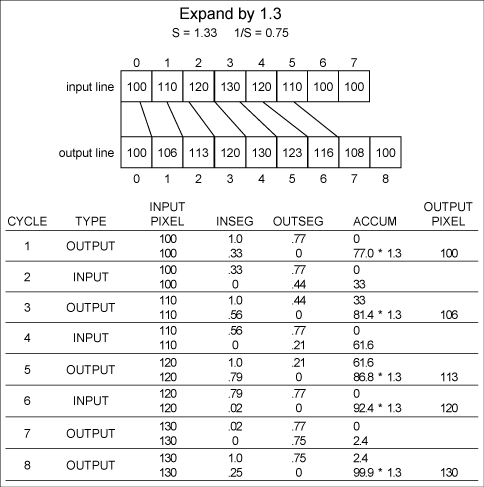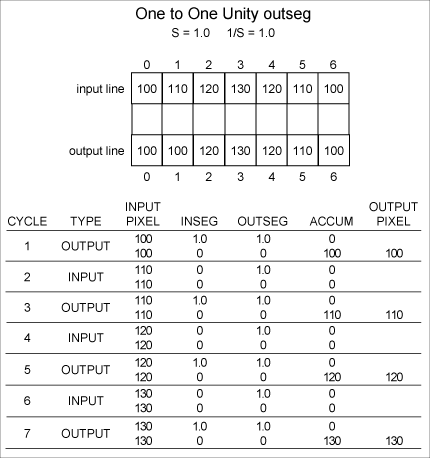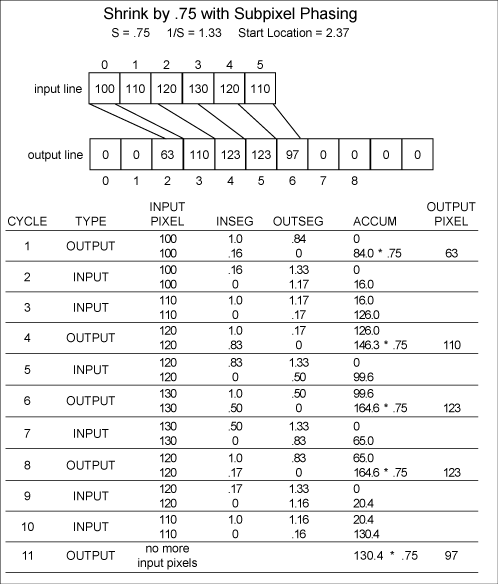Figure
3. Example of expansion.

For
the first cycle INSEG is smaller than OUTSEG.
The input pixel intensity is multiplied by INSEG
and added to the accumulator. INSEG is subtracted
from OUTSEG, the next input pixel is addressed,
and INSEG is reinitialized to 1.0.
For
the second cycle OUTSEG is smaller. The input
pixel is multiplied by OUTSEG and added to the
accumulator. OUTSEG is subtracted from INSEG and
is then reinitialized to 1.33. The contents of
the accumulator are scaled by SIZFAC, producing
the current output pixel value 102. The accumulator
is zeroed, and the next output pixel is addressed.
For
the third cycle INSEG is smaller. The input pixel
intensity is multiplied by INSEG and added to
the accumulator. INSEG is subtracted from OUTSEG,
the next input pixel is addressed, and INSEG is
reinitialized to 1.0.
For
the fourth cycle OUTSEG is smaller. The input
pixel is multiplied by OUTSEG and added to the
accumulator. OUTSEG is subtracted from INSEG and
is then reinitialized to 1.33. The contents of
the accumulator are scaled by SIZFAC, producing
the current output pixel value 115. The accumulator
is zeroed, and the next output pixel is addressed.
This
process continues until all input pixels are used
up or until all output pixels are completed. Figure
3 is an example of an expanding size factor;
Figure 4 is an example with
zero cycles.
Figure
4. Example with 2 zero cycles.

The
transform is complete in that all the information
from the input pixels contributed to the output
pixels. The resampling of the line of input pixels
is contiguous, without gaps, and without overlaps.
The transform is continuous in that the interplay
between INSEG and OUTSEG and the scaling of input
pixels can be performed with arbitrary precision.
Precision
Issues
The
precision sensitivity of the interpolation algorithm
is in the spatial domain rather than in the intensity
domain. The algorithm will always produce a smooth
output line free of intensity aliasing artifacts,
but there may be spatial position inaccuracies
in the output line. These inaccuracies can result
in spatial jitter between consecutive spatial
transforms on the right edge of the output line
(assuming that the algorithm proceeds from left
to right). This arises from the continued mutual
subtraction of INSEG and OUTSEG. Notice in Figure
3 that the final value of INSEG is 0.01 when
it should properly be 0.0. This is due to truncation
from carrying only two decimal digits of precision.
The significance of this 0.01 is that the output
line will be slightly longer than it should be.
After several hundred input pixels have been traversed,
this error grows, and the last output pixel may
be misplaced by one or more whole pixels beyond
where it should properly be. Such a spatial misregistration
is not important for many applications, but if
it is important to the application, sufficient
fractional precision must be carried with SIZFAC,
INSFAC, INSEG, and OUTSEG to satisfy the application.
For instance, to achieve 1/256 of a pixel accuracy
over 512 input pixels, about 24 fraction bits
are required.
The
algorithm is very insensitive to pixel intensity
mapping. The effects of precision on intensity
mapping can only be seen at the extremes of shrinking
and expanding, where factors overflow or underflow
their precision range, suddenly go to zero, and
the image disappears.
If,
for instance, INSFAC has eight integer bits, it
can specify that 255 input pixels be added to
the accumulator, which will then be scaled by
a SIZFAC of 1/255 to shrink a line by 1/255. A
correct average of 255 input pixel intensities
is generated for the output pixel. If, however,
a SIZFAC of 1/256 is attempted, INSFAC must represent
256 and set a ninth integer bit, which it doesn't
have, and it is suddenly zero. OUTSEG is always
smaller and equal to zero, so that all output
pixels are zero, and the output line disappears.
There was not a gradual degradation, but there
was integrity of intensity mapping until the limit
of precision was reached.
The
same thing occurs during expansion, where SIZFAC
is large. The intensity mapping is quite correct
until INSFAC underflows its fraction bits, becomes
zero, and the output line again disappears.
Subpixel
Positioning
Output
lines can be subpixel positioned, or phased in
the output line, by scaling the output pixel intensity
value proportionally to the fractional part of
the output pixel to be represented. A fractional
value scale can be superimposed on the pixel number
scale as shown in Figure 5.
The fractional position value 1.5 is halfway through
pixel 1. To position a line beginning at 1.5,
the first output pixel should be half its normal
intensity value. This can be accomplished simply
by initializing OUTSEG to 0.5 of INSFAC instead
of 1.0 of INSFAC. This makes the first, or leftmost,
pixel of the output line a partial-intensity pixel
and shifts the mapping of the entire line by half
an output pixel.
Figure
5. Real-valued scale over pixel grid.

When
the algorithm runs out of input pixels, the value
left in the accumulator is very likely not a full
output pixel's worth. This value is scaled by
SIZFAC and output as the last output pixel, which
will also be a partial-intensity pixel. So partial-intensity
output pixels are generated at the beginning and
end of the output line to represent continuous
subpixel positioning of the output line.
The
example in Figure 6 positions
an output line with a size factor of 0.75 to begin
at output location 2.37. The first output pixel
location is set to 2, and the initial value of
OUTSEG is (1.0-0.63) * INSFAC to indicate 0.63
of full intensity for the first output pixel.
Notice the partial intensity for the last output
pixel.
Figure
6. Example of subpixel phasing.

|